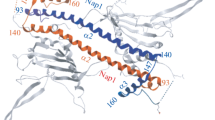Abstract
This article describes the formation of homodimers from their constituting monomers, based on the rules set by a simple model of electric and hydrophobic interactions. These interactions are described in terms of the electric dipole moment (D) and hydrophobic moment vectors (H) of proteins. The distribution of angles formed by the two dipole moments of monomers constituting dimers were analysed, as well as the distribution of angles formed by the two hydrophobic moments. When these distributions were fitted to Gaussian curves, it was found that for biological dimers, the D vectors tend mostly to adopt a perpendicular arrangement with respect to each other, in which the constituting dipoles have the least interaction. A minor population tends towards an antiparallel arrangement implying maximum electric attraction. Also in biological dimers, the H vectors of most monomers tend to interact in such a way that the total hydrophobic moment of the dimer increases with respect to those of the monomers. This shows that hydrophobic moments have a tendency to align. In dimers originating in the crystallisation process, the distribution of angles formed by both hydrophobic and electric dipole moments appeared rather featureless, probably because of unspecific interactions in the crystallisation processes. The model does not describe direct interactions between H and D vectors although the distribution of angles formed by both vectors in dimers was analysed. It was found that in most cases these angles tended to be either small (both moments aligned parallel to each other) or large (antiparallel disposition).



Similar content being viewed by others
References
Ali MH, Imperiali B (2005) Protein oligomerization: how and why. Bioorganic Med Chem 13:5013–5020
Ardejani MS, Orner BP (2013) Obey the peptide assembly rules. Science 340:561–562
Baldwin RL (2002) Making a network of hydrophobic clusters. Science 295:1657–1658
Barducci A, Bonomi M, Prakash MK, Parrinello M (2013) Free-energy landscape of protein oligomerization from atomistic simulations. Proc Natl Acad Sci 110:E4708–E4713
Bonjack-Shterengartz M, Avnir D (2014) The near-symmetry of proteins. Proteins 83:722–734
Eisenberg D, Weiss RM, Terwilliger TC (1982) The helical hydrophobic moment: a measure of amphiphilicity of a helix. Nature 299:371–374
Eisenberg D, Weiss RM, Terwilliger TC (1984) The hydrophobic moment detects periodicity in protein hydrophobicity. Proc Natl Acad Sci USA 81:140–144
Eswar N, Marti-Renom MA, Webb B, Madhusudhan MS, Eramian D, Shen M, Pieper U, Sali A (2006) Comparative protein structure modeling with MODELLER. Curr Prot Bioinform Chapter 2:Unit 2.9. doi:10.1002/0471140864.ps0209s50
Grueninger D, Treiber N, Ziegler MOP, Koetter JWA, Schulze M-S, Schulz GE (2008) Designed protein-protein association. Science 319:206–209
Hashimoto K, Panchenko A (2010) Mechanisms of protein oligomerization, the critical role of insertions and deletions in maintaining different oligomeric states. Proc Natl Acad Sci USA 107:20352–20357
Invernizzi G, Papaleo E, Sabate R, Ventura S (2012) Protein aggregation: mechanisms and functional consequences (Review). Intl J Biochem Cell Biol 44:1541–1554
Jones S, Thornton J (1996) Principles of protein–protein interactions. Proc Natl Acad Sci USA 93:13–20
Kortemme Baker D. T, Baker D (2004) Computational design of protein–protein interactions. Curr Opin Chem Biol 8:91–97
Levy Y, Onuchic J (2006) Mechanisms of protein assembly: lessons from minimalist models. Acc Chem Res 39:135–142
Marsh JA, Teichmann SA (2015) Structure, dynamics, assembly, and evolution of protein complexes. Annu Rev Biochem 84:5.1–5.25
Matthews JM (2012) Protein dimerization and oligomerization in biology. Springer, New York, p 170
Mozo-Villarías A, Cedano J, Querol E (2003) A simple electrostatic criterion for predicting the thermal stability of proteins. Protein Eng 16:279–286
Mozo-Villarías A, Cedano J, Querol E (2006) Hydrophobicity density profiles to predict thermal stability enhancement in proteins. Protein J 25:529–535
Mozo-Villarías A, Cedano J, Querol E (2014) A model of protein association based on their hydrophobic and electric interactions. PLoS One 9(10):e110352. doi:10.1371/journal.pone.0110352
Qiu H, Hudson ZM, Winnik MA, Manners I (2015) Multidimensional hierarchical self-assembly of amphiphilic cylindrical block comicelles. Science 347:1329–1332
Acknowledgments
This research was supported by Ministerio de Ciencia e Innovación of Spain [BIO2013-48704-R and BFU2013-50176-EXP], the Centre de Referència de R + D de Biotecnologia de la Generalitat de Catalunya and the Comisión Coordinadora del Interior de Uruguay. We thank Ms. Lynn Strother for revising the English text.
Author information
Authors and Affiliations
Corresponding author
Electronic supplementary material
Below is the link to the electronic supplementary material.
Rights and permissions
About this article
Cite this article
Mozo-Villarías, A., Cedano, J. & Querol, E. Vector description of electric and hydrophobic interactions in protein homodimers. Eur Biophys J 45, 341–346 (2016). https://doi.org/10.1007/s00249-015-1100-3
Received:
Revised:
Accepted:
Published:
Issue Date:
DOI: https://doi.org/10.1007/s00249-015-1100-3




